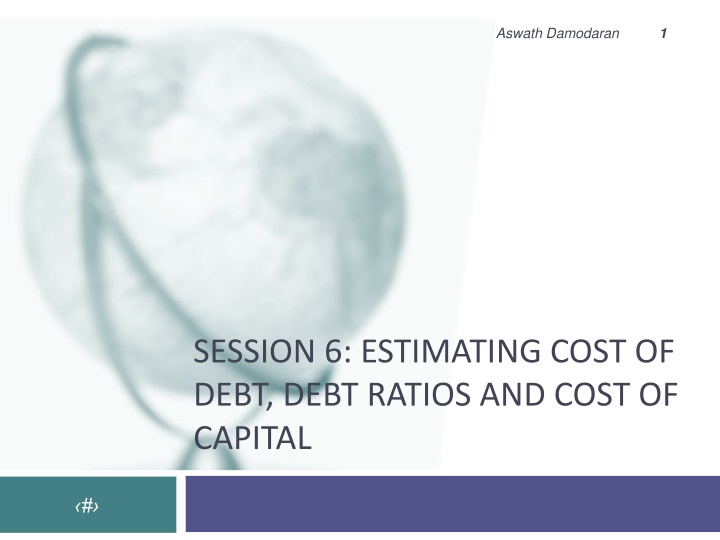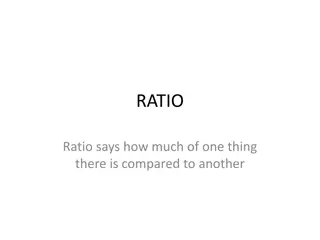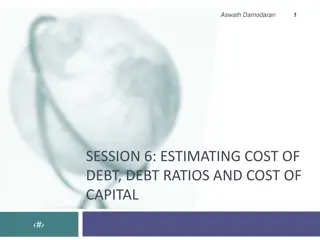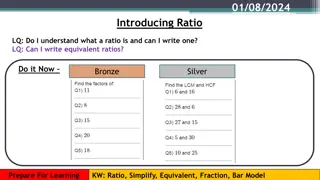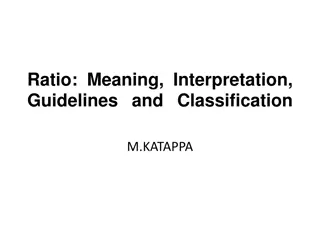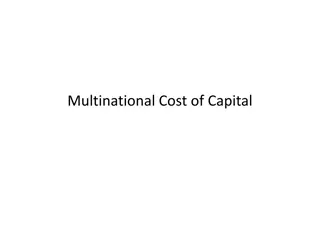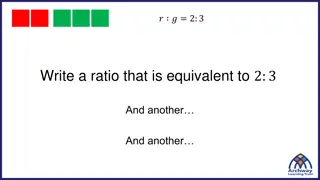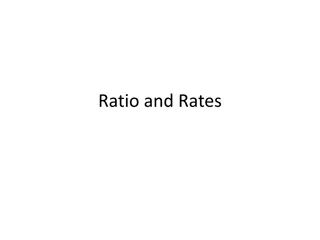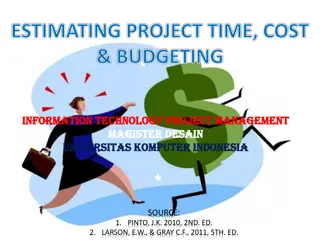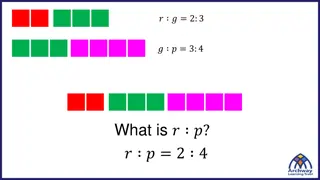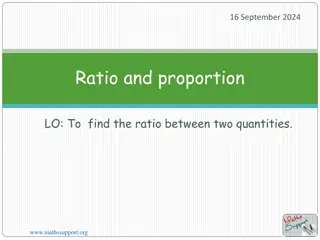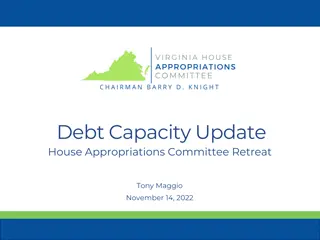Estimating Cost of Debt and Debt Ratios
Estimating the cost of debt is crucial for determining the cost of capital. Debt obligations must meet specific criteria to be classified as debt, including contractual commitments and tax deductibility. Learn about different approaches to estimating the cost of debt, including using bond ratings and interest coverage ratios to determine default spreads. Explore how interest coverage ratios can be used to estimate synthetic ratings for firms.
Download Presentation

Please find below an Image/Link to download the presentation.
The content on the website is provided AS IS for your information and personal use only. It may not be sold, licensed, or shared on other websites without obtaining consent from the author.If you encounter any issues during the download, it is possible that the publisher has removed the file from their server.
You are allowed to download the files provided on this website for personal or commercial use, subject to the condition that they are used lawfully. All files are the property of their respective owners.
The content on the website is provided AS IS for your information and personal use only. It may not be sold, licensed, or shared on other websites without obtaining consent from the author.
E N D
Presentation Transcript
Aswath Damodaran 1 SESSION 6: ESTIMATING COST OF DEBT, DEBT RATIOS AND COST OF CAPITAL #
Bringing debt into the capital equation 2 Aswath Damodaran 2
What is debt? 3 For an item to be classified as debt, it has to meet three criteria: It has to give rise to a contractual commitment, that has to be met in good times or bad. That commitment usually is tax deductible Failure to make that commitment can cost you control over the business. Using these criteria, all interest-bearing commitments, short term as well as long term, are clearly debt. So, are all lease commitments. The items below can be debt, if they meet other conditions Accounts payable & supplier credit, but only if you are willing to make the implicit interest expenses (the discounts lost by using the credit) explicit. Under funded pension and health care obligations, but only if there is a legal requirement that you cover the underfunding with fixed payments in future years. Aswath Damodaran 3
Estimating the Cost of Debt 4 The cost of debt is the rate at which you can borrow at currently, It will reflect not only your default risk but also the level of interest rates in the market. The two most widely used approaches to estimating cost of debt are: Looking up the yield to maturity on a bond issued by the firm. The limitation of this approach is that few firms have long term straight bonds that are liquid and widely traded. Looking up the bond rating for the firm and estimating a default spread based upon the rating. While this approach is more robust, different bonds from the same firm can have different ratings. You have to use a median rating for the firm When in trouble, either because you have no ratings or multiple ratings for a firm, estimate a synthetic rating for your firm and the cost of debt based upon that rating. Aswath Damodaran 4
Estimating Synthetic Ratings 5 The rating for a firm can be estimated using the financial characteristics of the firm. In its simplest form, the rating can be estimated from the interest coverage ratio Interest Coverage Ratio = EBIT / Interest Expenses For Embraer s interest coverage ratio, we used the interest expenses from 2003 and the average EBIT from 2001 to 2003. (The aircraft business was badly affected by 9/11 and its aftermath. In 2002 and 2003, Embraer reported significant drops in operating income) Interest Coverage Ratio = 462.1 /129.70 = 3.56 Aswath Damodaran 5
Interest Coverage Ratios, Ratings and Default Spreads: 2003 & 2004 6 If Interest Coverage Ratio is Estimated Bond Rating Spread(2004) > 8.50 (>12.50) 6.50 - 8.50 (9.5-12.5) AA 5.50 - 6.50 (7.5-9.5) A+ 4.25 - 5.50 (6-7.5) 3.00 - 4.25 (4.5-6) 2.50 - 3.00 (4-4.5) 2.25- 2.50 (3.5-4) 2.00 - 2.25 ((3-3.5) 1.75 - 2.00 (2.5-3) 1.50 - 1.75 (2-2.5) 1.25 - 1.50 (1.5-2) 0.80 - 1.25 (1.25-1.5) CCC 0.65 - 0.80 (0.8-1.25) CC 0.20 - 0.65 (0.5-0.8) C < 0.20 (<0.5) D Default Spread(2003) Default AAA 0.75% 1.00% 1.50% 1.80% 2.00% 2.25% 2.75% 3.50% 4.75% 6.50% 8.00% 10.00% 11.50% 12.70% 15.00% 0.35% 0.50% 0.70% 0.85% 1.00% 1.50% 2.00% 2.50% 3.25% 4.00% 6.00% 8.00% 10.00% 12.00% 20.00%. A A BBB BB+ BB B+ B B Aswath Damodaran 6
Cost of Debt computations 7 The cost of debt for a company is then the sum of the riskfree rate and the default spread: Pre-tax cost of debt = Risk free rate + Default spread Companies in countries with low bond ratings and high default risk might bear the burden of country default risk, especially if they are smaller or have all of their revenues within the country. Pre-tax cost of debt = Risk free rate + Company Default Spread + Country Default Spread Larger companies that derive a significant portion of their revenues in global markets may be less exposed to country default risk. In other words, they may be able to borrow at a rate lower than the government. The synthetic rating for Embraer is A-. Using the 2004 default spread of 1.00%, we estimate a cost of debt of 9.29% (using a risk free rate of 4.29% and adding in two thirds of the country default spread of 6.01%): Cost of debt = Riskfree rate + 2/3 (Brazil country default spread) + Company default spread =4.29% + 4.00%+ 1.00% = 9.29% Aswath Damodaran 7
Weights for the Cost of Capital Computation 8 In computing the cost of capital for a publicly traded firm, the general rule for computing weights for debt and equity is that you use market value weights. That is not because the market is right but because that is what it would cost you to buy the company in the market today, even if you think that the price is wrong. Aswath Damodaran 8
Getting a market value for debt: Disney 9 Convert book value of interest-bearing debt to market value, using a simple bond pricing equation. In 2013, Disney s total debt due, in book value terms, on the balance sheet is $14,288 million, the total interest expense for the year was $349 million and the weighted maturity of its debt was 3.75%. Using 3.75% as the pre-tax cost of debt: 1 Estimated MV of Disney Debt = (1- 14,288 (1.0375)7.92=$13,028 million (1.0375)7.92 .0375 + 349 To convert leases into debt, you take the PV of lease commitments in the future @3.75% 1 $507.00 2 $422.00 3 $342.00 4 $272.00 5 $217.00 6-10 $356.80 Debt value of leases Year Commitment Present Value @3.75% $488.67 $392.05 $306.24 $234.76 $180.52 $1,330.69 $2,932.93 Disney reported $1,784 million in commitments after year 5. Given that their average commitment over the first 5 years, we assumed 5 years @ $356.8 million each. Aswath Damodaran 9
Estimating Cost of Capital: Embraer in 2004 10 Equity Cost of Equity = 4.29% + 1.07 (4%) + 0.27 (7.89%) = 10.70% Market Value of Equity =11,042 million BR ($ 3,781 million) Debt Cost of debt = 4.29% + 4.00% +1.00%= 9.29% Market Value of Debt = 2,083 million BR ($713 million) Cost of Capital Cost of Capital = 10.70 % (.84) + 9.29% (1- .34) (0.16)) = 9.97% Aswath Damodaran 10
If you had to do it.Converting a Dollar Cost of Capital to a Nominal Real Cost of Capital 11 Approach 1: Use a BR riskfree rate in all of the calculations above. For instance, if the BR riskfree rate was 12%, the cost of capital would be computed as follows: Cost of Equity = 12% + 1.07(4%) + Cost of Debt = 12% + 1% = 13% (This assumes the riskfree rate has no country risk premium embedded in it.) Approach 2: Use the differential inflation rate to estimate the cost of capital. For instance, if the inflation rate in BR is 8% and the inflation rate in the U.S. is 2% 27 (7. %) = 18.41% (1+Cost of Capital$)1+InflationBR Cost of capital= 1+Inflation$ = 1.0997 (1.08/1.02)-1 = 0.1644 or 16.44% Aswath Damodaran 11
Dealing with Hybrids and Preferred Stock 12 When dealing with hybrids (convertible bonds, for instance), break the security down into debt and equity and allocate the amounts accordingly. Thus, if a firm has $ 125 million in convertible debt outstanding, break the $125 million into straight debt and conversion option components. The conversion option is equity. When dealing with preferred stock, it is better to keep it as a separate component. The cost of preferred stock is the preferred dividend yield. (As a rule of thumb, if the preferred stock is less than 5% of the outstanding market value of the firm, lumping it in with debt will make no significant impact on your valuation). Aswath Damodaran 12
Recapping the Cost of Capital 13 Aswath Damodaran 13
